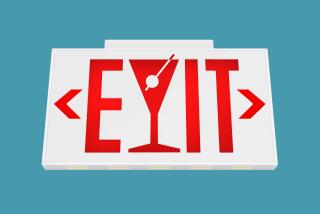Overeaters Struggle With Season of Plenty
- Share via
On a Thursday evening at a Quaker meeting house in the shadow of a McDonald’s in Santa Monica, 50 men and women with a common concern--their weight--sit in a circle in folding chairs. At precisely 6:30, tonight’s leader, a slender, attractive young woman with dark, wavy shoulder-length hair, opens the meeting. “I’m a compulsive overeater. My name is Laura.” In unison, the group responds, “Hi, Laura.”
In unison, they then recite the Serenity Prayer.
“God, grant me the serenity to accept the things I cannot change, courage to change the things I can, and wisdom to know the difference.”
Laura asks, “Are there any compulsive overeaters here besides me?” Hands fly up.
Michelle then reads the preamble, the statement of mission familiar to every member of OA: “Overeaters Anonymous is a fellowship of individuals who, through shared experience, strength, and hope, are recovering from compulsive overeating. We welcome everyone who wants to stop eating compulsively . . . .”
Everyone in the room knows that this is the worst time of year for a compulsive overeater, a time when there is the temptation of food everywhere you go. It is not just a season of high risk for the emotionally fragile, but also a season of warnings about a growing obesity epidemic that is threatening the health of millions of Americans.
A visitor happening upon this meeting would be surprised to learn that these are overeaters, a fact belied by the number of slender young women.
After the meeting, Ann, a journalist who used to be overweight, draws the analogy of a stranger coming to a meeting of Alcoholics Anonymous and saying, “You guys aren’t drunk. Why are you at an AA meeting?”
Says Ann, who once weighed nearly 200 pounds and is now at a normal weight: “If we were to drift away, we’d all be large.”
Ben has been chosen tonight to read OA’s 12 steps, a blueprint for recovery based on AA’s 12-step program. Among its tenets: Admitting powerlessness over food and accepting the help of a higher power in the battle against compulsive overeating.
Then, says Laura, “it’s time for me to share.” To this day, she says, she is “powerless over food.” She tells of eating her way through her freshman year at college, gaining 50 pounds, of the “up and down” struggle to lose it. She’d turned to OA in 1978, dropped out, then re-found the program in 1986 when she was finally “ready to concede that I have this disease. . . . I share this disease with everybody in the room.”
She has learned to be content with what she calls “patient progress” and focuses on changing her attitude from negative to positive. It’s not unlike being caught in rush-hour traffic, she suggests. You can conclude angrily that those other drivers are bent on frustrating you--or you can “thank God I have this automobile.”
Less than half an hour into the hourlong meeting, it is time for the three-minute “pitches,” which are brief barings of souls, an important component of every OA meeting. Linda, an actress, speaks first. She tells of her fear of impending gall bladder surgery. And she shares the humiliation of her pre-op weigh-in, when she learned that her weight was up even as her height was down. Still, she says, she has learned through OA that “my height and weight are not who I am,” and that change is possible.
When Michael speaks, he says he is “feeling quite good, subject to change at any moment . . . . When my life is busy and my life is full, I don’t seem to think of food as much.” Like an alcoholic abstaining from drink, he is abstaining from sugar--one day at a time.
Connie speaks next. “I’ve been pushing stuff down for days now.” Sobbing, she tells how a friend, only 20, had recently killed himself, of her rage and the comfort she sought in food. “I want to heal,” she says. “I want to get better. I’m scared I’m going to end up like him. . . . I’m powerless over food. I cannot stop bingeing. I’m on the floor. I don’t want to die.”
Arthur, a heavyset man with a gray beard, has been sitting alone in a corner. Now he speaks. “I haven’t shared in this room for about eight years.” He drifted away, he says, because he “began feeling old and isolated,” which led him to go home and eat. Now, going through “the darkest period of my life,” he has come tonight to reconnect.
Amy, a trim young woman who works in the entertainment industry and identifies herself as bulimic, says, “I can’t stop eating. Everything sets me off.” When she is “down and in trouble,” she would like to call her sponsor in OA but, since childhood, has been unable to admit weakness. “I grew up with the Great Santini. If you ever showed pain or anger, you were punished.”
Later, Amy explained, “I’m normal weight, normal size. There are a lot of people in OA who are chronic binge eaters. The behavior is the same as with someone who weighs 300 pounds. It’s just how you deal with it.”
Now 32, Amy has been bingeing and purging since she was 13. Like compulsive overeating, she says, “it’s a way to not deal with emotions you just don’t want to feel. It was very important for me to maintain an attractive exterior. I wanted to eat to dull the pain, but I didn’t want the consequences.”
She still obsesses about food but through OA has been able to stop purging for more than a month, a milestone, and she has learned that if she practices the 12 steps and uses the “tools” that the steps provide, OA does work. But right now, “I can’t stop the bingeing.I’ve just been bingeing and bingeing and bingeing. I’m afraid of gaining weight. I’m out of control. The bingeing isn’t stopping the feelings anymore.”
When she binges, she eats so much at a sitting that she literally makes herself sick. Typically, it might be two quarts of ice cream, half a cake, a box of cookies, a hamburger and French fries, a Coke, a couple of pieces of pizza and a few candy bars.
The group listens to those who have chosen to speak, responding perhaps with a friendly squeeze of a hand or a comforting arm around a shoulder. But they do not offer unsolicited advice. That is not the object.
They’ve all been there, and they understand that this sharing may be a first statement of self-awareness, delivered in a safe place. Or it may be a cry for help. Some want input; others don’t. If it is a cry for help, others who have experienced the same emotions may connect with them after the meeting.
There are a few minutes of silent meditation. Standing and holding hands, the group recites the Lord’s Prayer.
Then, in unison, they say, “Keep coming back. It works.”


